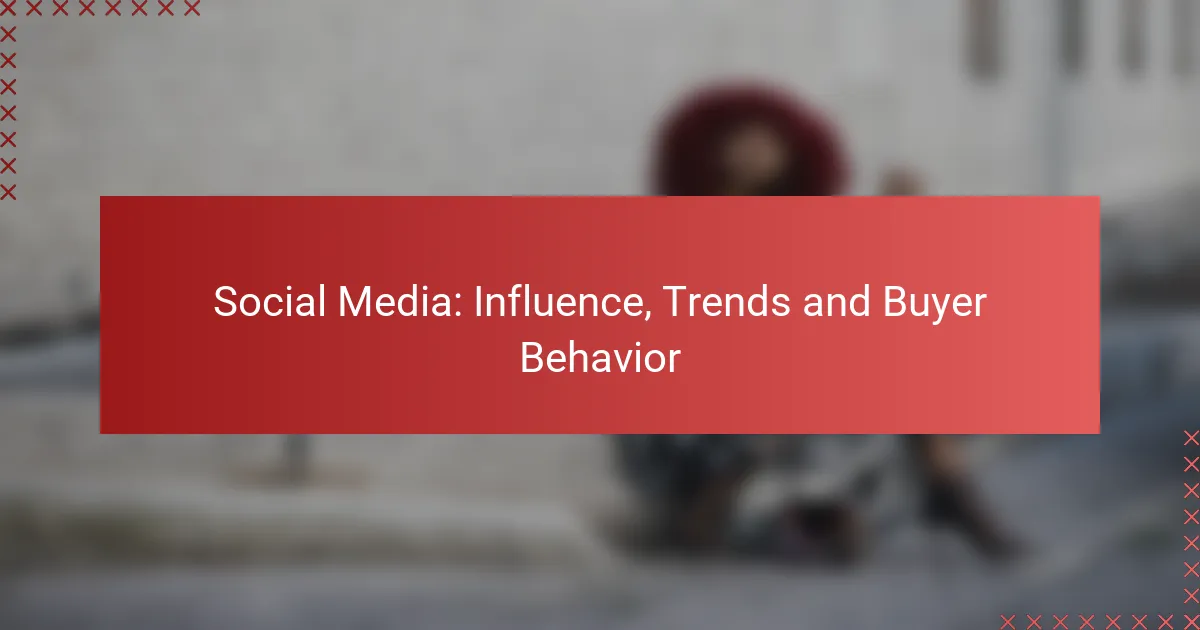Social media plays a crucial role in influencing buyer behavior by shaping consumer perceptions and driving purchasing decisions. With platforms like Instagram and Facebook facilitating brand discovery and engagement, current trends such as live shopping events and influencer marketing are transforming how businesses connect with their audiences and boost sales.
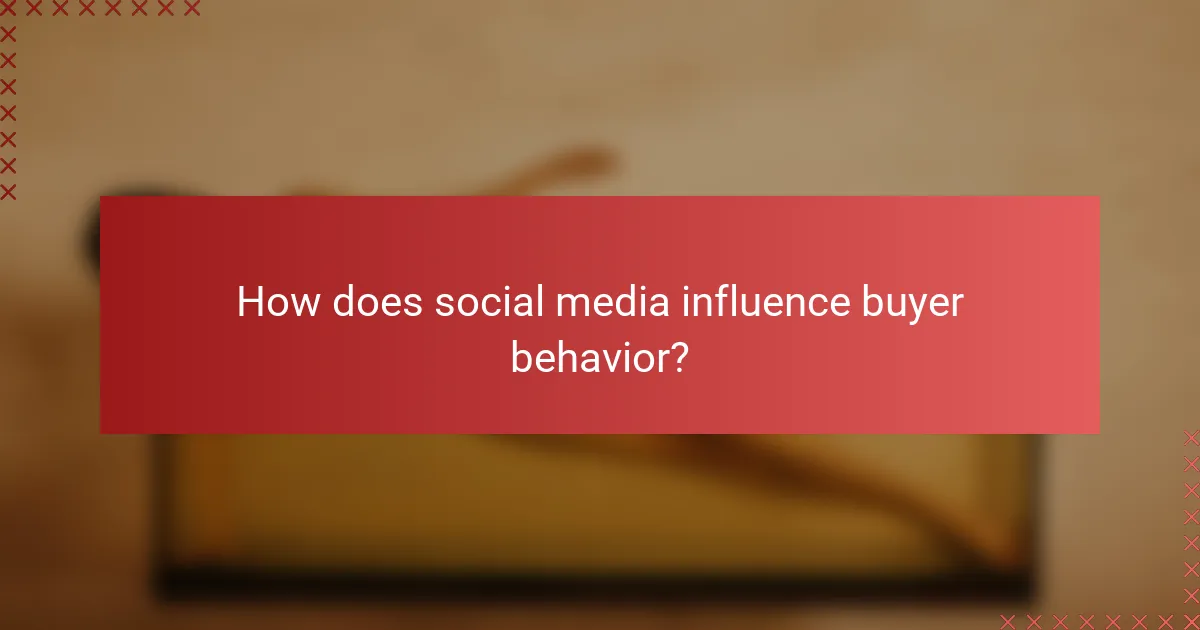
How does social media influence buyer behavior?
Social media significantly influences buyer behavior by shaping perceptions, enhancing interactions, and driving purchasing decisions. Platforms like Instagram, Facebook, and Twitter create environments where consumers can discover brands, engage with content, and share their experiences, ultimately impacting their buying choices.
Increased brand awareness
Social media increases brand awareness by allowing businesses to reach a broader audience through targeted advertising and organic content. Brands can showcase their products and services, making them more recognizable to potential customers. For example, a small local bakery can use Instagram to share mouth-watering images of its pastries, attracting new customers in the area.
Utilizing hashtags and engaging with trending topics can further amplify visibility. Brands should consistently post and interact with followers to maintain a strong presence and keep their audience informed about new offerings or promotions.
Enhanced customer engagement
Social media enhances customer engagement by providing platforms for real-time interaction between brands and consumers. This two-way communication fosters relationships, as customers feel heard and valued. For instance, a clothing retailer can respond to customer inquiries on Twitter, addressing concerns and building loyalty.
Brands should encourage feedback and create interactive content, such as polls or Q&A sessions, to deepen engagement. Regularly updating followers with behind-the-scenes content or exclusive deals can also keep the audience interested and involved.
Social proof and reviews
Social proof, such as reviews and testimonials, plays a crucial role in influencing buyer behavior on social media. Consumers often rely on the experiences of others when making purchasing decisions. Positive reviews can significantly boost a brand’s credibility, while negative feedback can deter potential buyers.
Encouraging satisfied customers to share their experiences on social media can enhance a brand’s reputation. Brands should actively monitor reviews and respond to both positive and negative feedback to show they value customer opinions and are committed to improving their offerings.
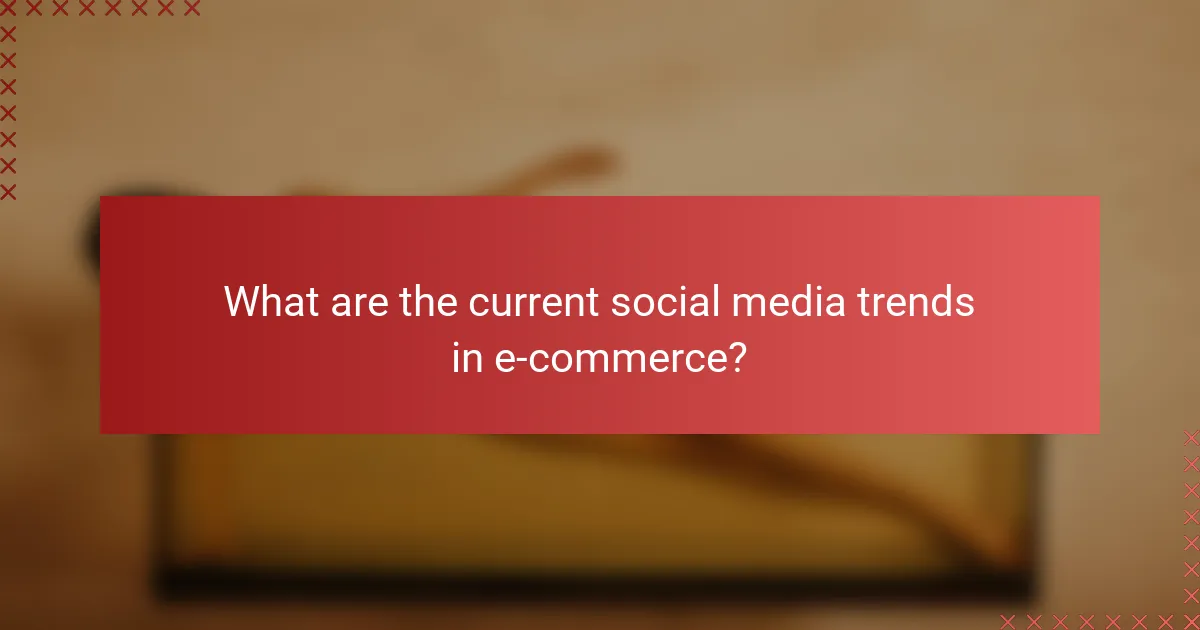
What are the current social media trends in e-commerce?
Current social media trends in e-commerce include the rise of live shopping events, the growth of influencer marketing, and the increasing popularity of short-form video content. These trends significantly shape how brands engage with consumers and drive sales through social platforms.
Rise of live shopping events
Live shopping events have gained traction as a dynamic way to showcase products in real-time. Brands host live streams on platforms like Instagram and Facebook, allowing viewers to interact and make purchases instantly. This format combines entertainment with shopping, creating a sense of urgency and exclusivity.
Consider hosting live events during peak shopping seasons or product launches to maximize engagement. Promote these events in advance to build anticipation and ensure a larger audience. Brands can also collaborate with popular hosts to attract more viewers.
Influencer marketing growth
Influencer marketing continues to expand as brands leverage the trust and reach of social media personalities. Collaborating with influencers can enhance brand visibility and credibility, particularly among younger demographics. Influencers often create authentic content that resonates with their followers, leading to higher conversion rates.
When selecting influencers, focus on those whose audience aligns with your target market. Micro-influencers, who have smaller but highly engaged followings, can be particularly effective and often more cost-efficient than larger influencers.
Short-form video content popularity
Short-form video content, exemplified by platforms like TikTok and Instagram Reels, is becoming a preferred medium for engaging consumers. These brief videos capture attention quickly and are easily shareable, making them ideal for showcasing products and promotions.
Brands should create concise, visually appealing videos that highlight key product features or tell a story. Regularly posting this type of content can help maintain visibility and engagement. Experiment with trends and challenges to increase reach and connect with a broader audience.

How can businesses leverage social media for sales?
Businesses can effectively leverage social media for sales by utilizing targeted advertising, creating engaging content, and encouraging user-generated content. These strategies help to reach specific audiences, foster community engagement, and enhance brand loyalty, ultimately driving sales growth.
Targeted advertising strategies
Targeted advertising allows businesses to reach specific demographics based on interests, behaviors, and location. Platforms like Facebook and Instagram provide robust tools for segmenting audiences, enabling companies to tailor their ads for maximum impact.
To implement effective targeted advertising, businesses should define their ideal customer profiles and use analytics to refine their strategies. A/B testing different ad formats and messages can also help identify what resonates best with the target audience.
Building community through content
Creating valuable content is essential for building a community around a brand. This can include blog posts, videos, and interactive posts that encourage engagement and discussion among followers.
Regularly posting content that aligns with the interests of the audience fosters a sense of belonging and loyalty. Businesses should consider hosting live Q&A sessions or webinars to deepen connections and provide direct value to their community.
Utilizing user-generated content
User-generated content (UGC) is a powerful tool for enhancing brand credibility and engagement. Encouraging customers to share their experiences with products can create authentic testimonials that resonate with potential buyers.
To effectively utilize UGC, businesses can run contests or campaigns that incentivize customers to share their content. Highlighting this content on official channels not only showcases customer satisfaction but also builds trust with new audiences.

What metrics should be tracked for social media success?
To measure social media success, focus on key metrics that reflect user interaction, conversion effectiveness, and cost efficiency. Tracking these metrics helps businesses understand their performance and optimize their strategies for better results.
Engagement rates
Engagement rates indicate how well your audience interacts with your content, typically measured through likes, shares, comments, and overall reach. A higher engagement rate suggests that your content resonates with your audience, which is crucial for building brand loyalty.
To calculate engagement rate, divide the total engagement (likes, comments, shares) by the total number of followers, then multiply by 100 to get a percentage. Aim for engagement rates between 1% and 5% for most industries, though this can vary significantly by sector.
Conversion rates
Conversion rates measure the percentage of users who take a desired action, such as making a purchase or signing up for a newsletter, after interacting with your social media content. This metric is vital for assessing the effectiveness of your social media campaigns in driving sales or leads.
To improve conversion rates, ensure your calls-to-action (CTAs) are clear and compelling. A typical conversion rate for social media can range from 1% to 3%, but optimizing your landing pages and targeting can help increase this figure.
Customer acquisition cost
Customer acquisition cost (CAC) refers to the total cost of acquiring a new customer through social media marketing, including advertising spend, content creation, and personnel costs. Understanding CAC is essential for evaluating the profitability of your marketing efforts.
To calculate CAC, divide your total marketing expenses by the number of new customers acquired in a specific period. A lower CAC indicates more efficient marketing, with a target of around $10 to $50 per customer being common, depending on the industry.
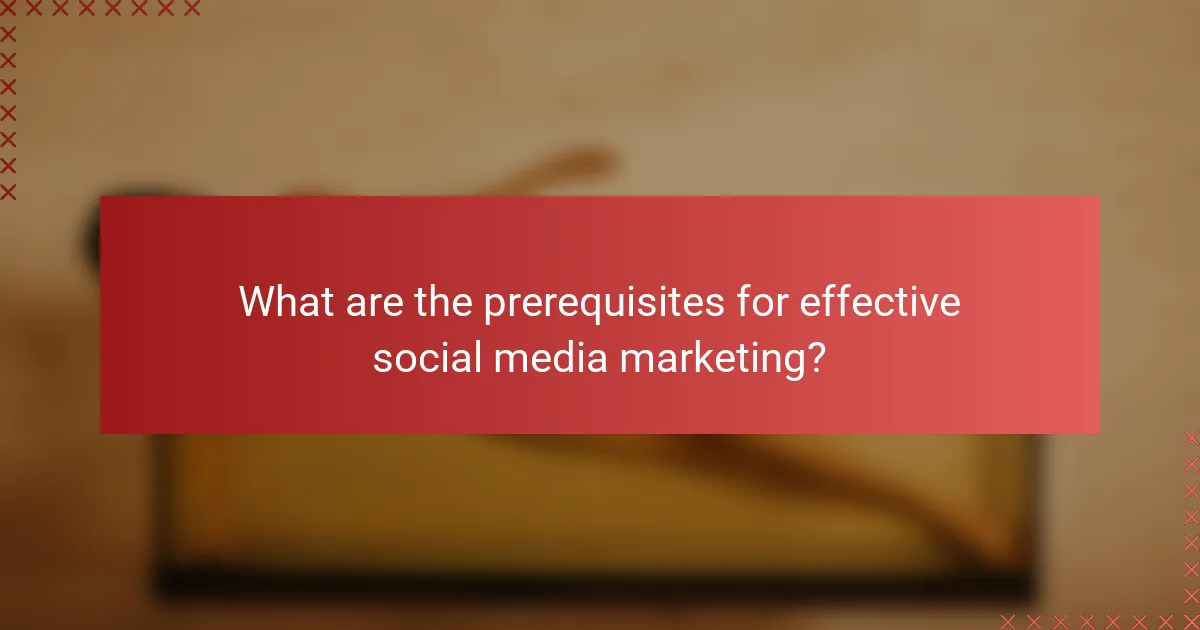
What are the prerequisites for effective social media marketing?
Effective social media marketing requires a clear understanding of your target audience and well-defined marketing goals. These prerequisites help shape your strategy and ensure that your efforts resonate with potential customers.
Understanding target audience
To effectively engage your audience, you must identify their demographics, interests, and online behaviors. This involves researching age groups, gender, location, and preferences, which can vary significantly across platforms.
Utilize tools like surveys, social media analytics, and customer feedback to gather insights. For instance, if your target audience is primarily young adults, platforms like Instagram and TikTok may be more effective than Facebook.
Setting clear marketing goals
Establishing specific, measurable, achievable, relevant, and time-bound (SMART) goals is crucial for guiding your social media strategy. Goals could include increasing brand awareness, generating leads, or boosting sales by a certain percentage within a defined period.
For example, a goal might be to increase your follower count by 20% over the next three months or to drive a specific number of website visits from social media channels. Regularly review and adjust these goals based on performance metrics to stay aligned with your overall business objectives.
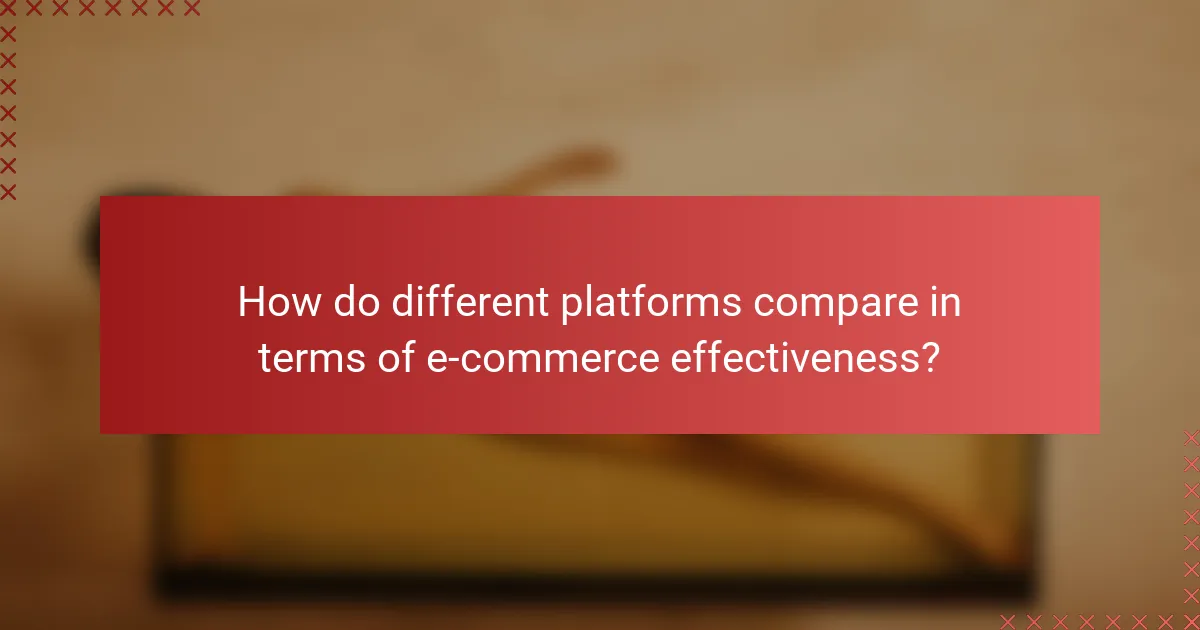
How do different platforms compare in terms of e-commerce effectiveness?
Different social media platforms exhibit varying levels of effectiveness for e-commerce, influenced by user demographics, engagement styles, and features. Instagram tends to excel in visual product discovery, while Facebook offers a more comprehensive shopping experience through integrated features.
Instagram vs. Facebook for product discovery
Instagram is highly effective for product discovery due to its visually-driven format, making it ideal for brands that rely on aesthetics. Users often engage with shoppable posts and stories, leading to impulsive purchases. Brands can leverage features like Instagram Shopping to tag products directly in their posts.
In contrast, Facebook provides a broader range of shopping tools, including Marketplace and Shops, which cater to a diverse audience. While it may not be as visually appealing as Instagram, Facebook’s extensive user base allows for targeted advertising and community engagement, which can drive sales effectively.
TikTok’s impact on younger demographics
TikTok has rapidly gained traction among younger demographics, particularly Gen Z and Millennials, making it a powerful platform for e-commerce. The short-form video format encourages creativity and authenticity, allowing brands to connect with users in a relatable manner.
Brands can utilize TikTok’s unique features, such as challenges and influencer partnerships, to create viral content that drives product awareness. As a result, many companies are seeing significant engagement and conversion rates, particularly when targeting trends that resonate with younger audiences.
